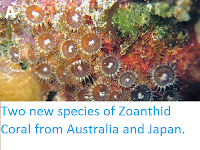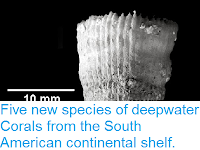Golden Corals, Chrysogorgiidae, are Octocorals (colonial Corals with eight-fold symmetry) found in all the world's oceans, predominantly in deepwater environments. They are members of the Alcyonacea (Soft Corals), but have a tough proteinaceous skeleton comprising a central stem, a covering of sclerites (scales) and a holdfast which is often calcified. Recent genetic studies have suggested the group is in fact polyphyletic (do nor share a common ancestry).
In a paper published in the journal ZooKeys on 12 April 2017, Stephen Cairns of the Department of Invertebrate Zoology at the National Museum of Natural History and Ralf Cordeiro of the Programa de Pós-Graduação em Biologia Animal at the Universidade Federal de Pernambuco, describe a new species of Golden Coral from the waters off the southeastern coast of the United States, from North Carolina in the north to Florida in the south.
The new species is named Flagelligorgia gracilis, where 'Flagelligorgia' derives from the Latin for whip (flagellum), due to the shape of the colonies, plus Gorgon (gorgia) a common suffix for Octocoral groups, and 'gracilis' means slender. The species is described not from newly discovered specimens, but from museum specimens collected between 1885 and 1965, previously assigned to the genus Radicipes, but re-examined as part of a re-evaluation of the group.
Diagnostic characters of Flagelligorgia gracilis. (A) General view of the holotype attached to a rocky substrate. (B) Detail of the holotype showing the biserial arrangement of polyps. (C), (E) Cross-section of the stem of the holotype showing its four rounded longitudinal cords. (D) Detail of undulating concentric layers of the stem in cross-section. Scale bars: (A) 10 mm, (B) 5 mm, (C), (E) 0.1 mm, (D) 0.01 mm. Cairns & Cordiero (2017).
The Coral forms unbranched colonies reaching about 19 mm in length, with polyps arranged in a spiral fashion.The central stem is made up of four rounded protein cords, is golden in colour, and is attached by an encrusting holdfast to hard substrates such as other Corals or the shells of other invertebrates, on the continental shelf at depths of 196-567 m.
Detailed view of polyps and axis in Flagelligorgia gracilis through Scanning Electron Microscopy. (A) Stereo view of polyps. (B) Oral view of a polyp. (C) Stereo view of a polyp’s abaxial side. (D) Stereo view of the axis. Scale bars: (A), (C) 0.2 mm, (B) 0.04 mm, (D) 0.01 mm. Cairns & Cordiero (2017).
See also...


Follow Sciency Thoughts on Facebook.






